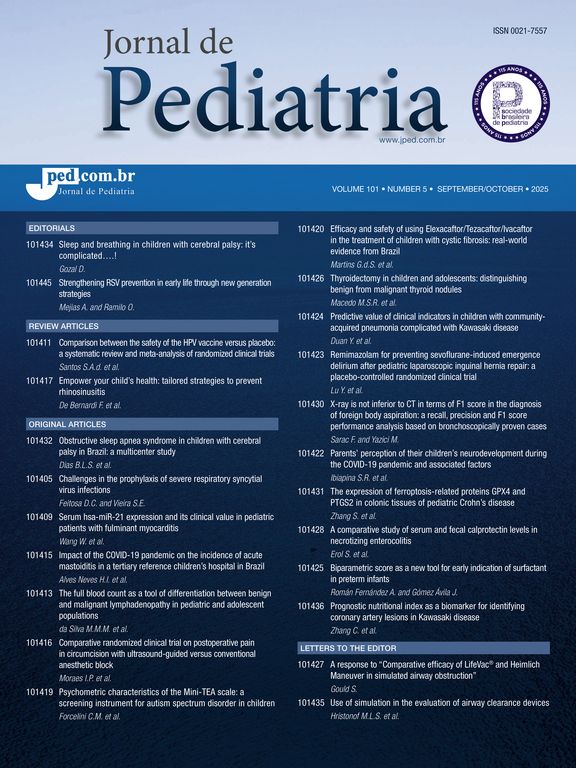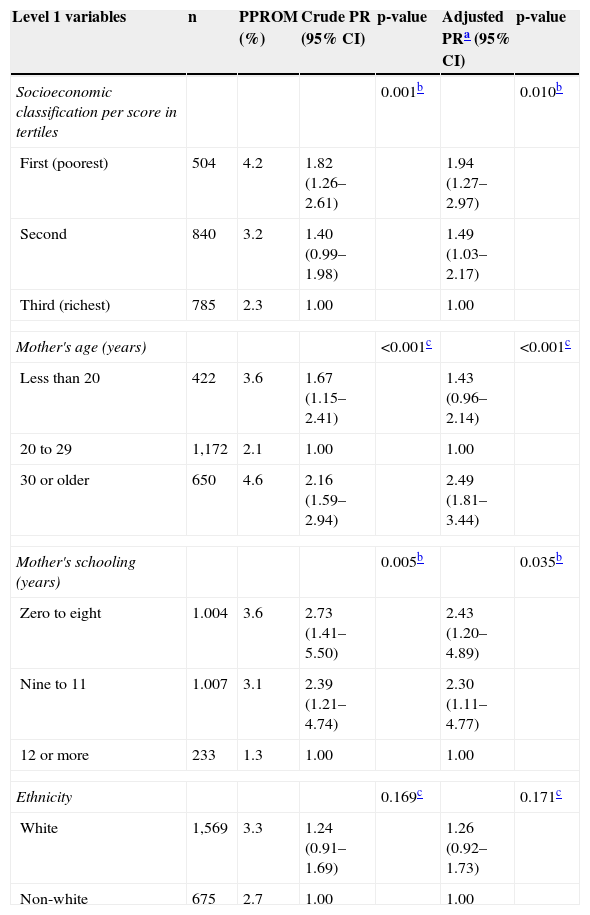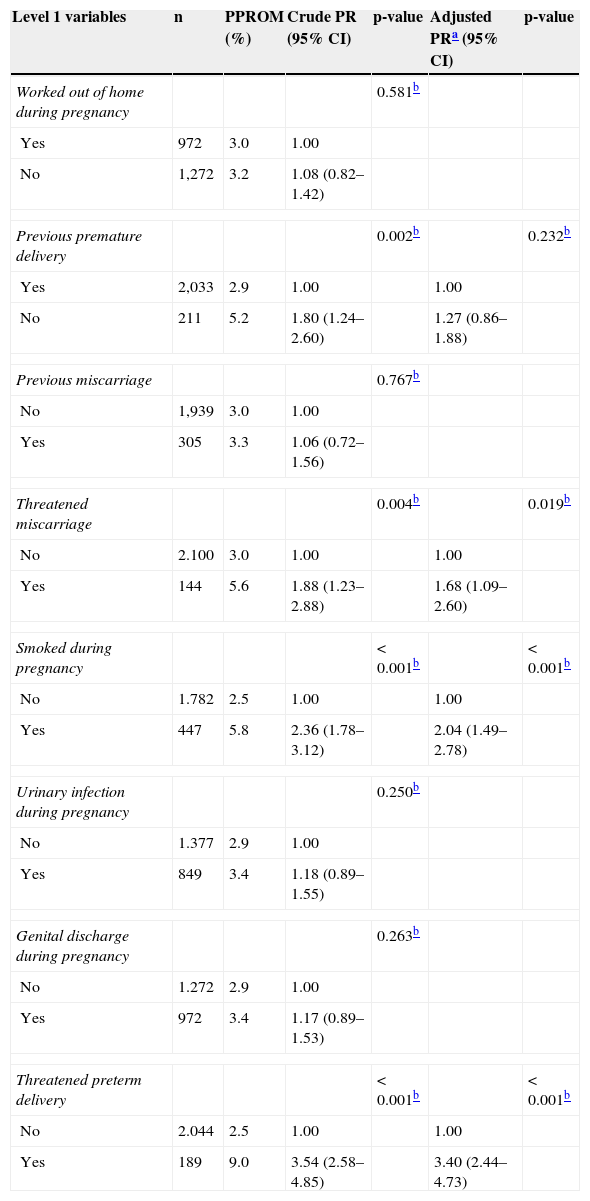this study aimed to investigate the incidence of premature rupture of fetal membranes in preterm singleton pregnancies and its association with sociodemographic factors and maternal self-reported genitourinary infections.
Methodsthis was a population-based cross-sectional study, which included all mothers of newborns of singleton deliveries that occurred in 2010, with birth weight ≥ 500 grams, who resided in the city of Rio Grande. Women were interviewed in the two maternity hospitals. Cases were women who had lost amniotic fluid before hospitalization and whose gestational age was less than 37 weeks. Statistical analysis was performed by levels to control for confounding factors using Poisson regression.
Resultsof the 2,244 women eligible for the study, 3.1% had preterm premature rupture of fetal membranes, which was more frequent, after adjustment, in women of lower socioeconomic status, (prevalence ratio [PR]=1.94), with lower level of schooling (PR=2.43), age > 29 years (PR=2.49), and smokers (PR=2.04). It was also associated with threatened miscarriage (PR=1.68) and preterm labor, (PR=3.40). There was no association with maternal urinary tract infection or presence of genital discharge.
Conclusionsthe outcome was more common in puerperal women with lower level of schooling, lower socioeconomic status, older, and smokers, as well as those with a history of threatened miscarriage and premature labor. These factors should be considered in the prevention, diagnosis, and therapy approach.
o objetivo deste estudo foi verificar a ocorrência da ruptura prematura das membranas fetais pré-termo em gestações únicas e sua associação com fatores sociodemográficos maternos e infecções geniturinárias autorreferidas.
Métodosestudo transversal de base populacional onde foram incluídas todas as mães dos recém-nascidos dos partos únicos ocorridos no ano de 2010, com peso ao nascer igual ou superior a 500 gramas, residentes no município. As puérperas foram entrevistadas nas duas maternidades da cidade. Foram considerados casos as gestantes que perderam líquido amniótico antes da internação hospitalar e cujo tempo de gestação fosse inferior a 37 semanas. Foi realizada análise estatística por níveis, para controle de fatores de confusão por meio da regressão de Poisson.
Resultadosdas 2.244 mulheres elegíveis para o estudo, 3,1% apresentaram ruptura prematura das membranas fetais pré-termo, a qual foi mais frequente, após ajuste, nas mulheres de menor nível econômico, razão de prevalência (RP) de 1,94, menor escolaridade, RP de 2,43, com idade superior a 29 anos, RP de 2,49 e tabagistas, RP de 2,04. Também esteve relacionada com ameaça de aborto, RP de 1,68, e de trabalho de parto pré-termo, RP de 3,40. Não houve associação com infecção urinária materna ou presença de corrimento genital.
Conclusõeso desfecho foi mais frequente nas puérperas com menor escolaridade, mais pobres, mais velhas e tabagistas, assim como naquelas com histórico de ameaça de abortamento e trabalho de parto prematuro. Estes fatores devem ser considerados na sua abordagem preventiva, diagnóstica e terapêutica.
Preterm premature rupture of fetal membranes (PPROM) is defined as loss of amniotic fluid before the onset of labor in pregnancies of less than 37 weeks.1 This condition occurs in approximately 3% of pregnancies.2
PPROM is associated with maternal and fetal pathologies, contributing to the birth of premature infants.3 The longer the time elapsed between rupture and delivery, the greater the chance of infection for both mother and fetus.4
The most common cause of PPROM is spontaneous, which has a multifactorial etiology. It may be related to a structural defect in the membranes due to collagen deficiency or malformation, to the weakening of the membranes due to enzymatic destruction in inflammatory or infectious processes, and to sac exposure due to isthmus-cervix incompetence. PPROM risk is increased if the mother has had previous occurrence of PPROM and low body mass index.5 Its occurrence is also related to mechanical factors, such as twin pregnancies, due to distended uterine volume.6 There is a hypothesis of the association between PPROM and genitourinary infections, but there is no consensus in this regard.
The available studies on PPROM in developed countries are case-control, and do not consider factors such as level of schooling and maternal age.7–9 These factors are important when observing the increase in the number of infants born prematurely.10
The association between prematurity and PPROM indicates the need to investigate its occurrence in singleton pregnancies and its association with maternal socioeconomic factors and self-reported genitourinary infections, and thus, to develop hypotheses for its occurrence and direct measures of disease prevention.
MethodsThis was a population-based cross-sectional study. The sample included all mothers of newborns of singleton deliveries in 2010, with birth weight ≥ 500g, whose mothers resided in Rio Grande, Brazil, and signed an informed consent. Mothers who did not live in Rio Grande, multiparous women, and those who refused to participate in the study were excluded.
Data were collected through a single, pre-coded, semi-open questionnaire by interviewers in the two maternity hospitals of the city during hospitalization in the first 72hours after birth. The signs and symptoms present prior to hospitalization, such as loss of fluid, blood, or uterine contractions, were retrospectively evaluated. The occurrence of all maternal diseases that occurred during pregnancy and those prior to pregnancy, as well as data on sociodemographic status, were investigated.
PPROM was considered when the women had shown loss of amniotic fluid before hospitalization and had gestational age < 37 weeks. The gestational age variable was assessed based on the last menstrual period. When the date of last menstrual period was not be recalled, the gestational age estimated by ultrasonography performed between the fifth and 20th week of pregnancy was used, followed by the method of Capurro11 performed by the pediatrician. Socioeconomic classification was performed using the Brazilian economic classification criteria of the Brazilian Association of Research Companies, based on possession of items and the head of the family's level of schooling.12 Skin color was observed by the interviewer.
Cases of self-reported urinary tract infection were considered in cases of symptomatic infections and asymptomatic bacteriuria, the latter detected during routine prenatal care.13 Cases of self-reported genital discharge were considered, in which the women had a non-white vaginal discharge, associated with bad odor, itching, or dyspareunia.14
The missing values were not analyzed; 4.7% of the data on gestational age were unknown. The variable with the greatest amount of missing information was the socioeconomic level, due to the rate of 5.2% lack of data on the years of schooling of the child's father. The analyses had a significance level of 95%. Gestational age was used as reference to calculate sample size, obtaining a prevalence ratio of 1.6, considering the 10% occurrence rate of premature rupture of membranes in term pregnancies (85% in the study population), and 15% were added to the sample size to control for confounders. Thus, 2,231 interviews were required.
Multivariate analysis was based on the conceptual model for hierarchical levels,15 and was performed using Poisson regression, controlling for confounding factors. Those variables that maintained a p-value ≤ 0.20 in the univariate analysis were included in the multivariable analysis. The study was approved by the Ethics Committee of Universidade Federal do Rio Grande (FURG).
ResultsA total of 2,355 women with singleton pregnancies were interviewed, of whom 18 refused to participate in the study; there were 51 losses by hospital discharge before 72hours after birth. PPROM rate was 3.1%. This proportion was 23.6% in preterm pregnancies.
It was observed that 18.8% of the mothers were adolescents, 44.7% had eight years or less of schooling, 69.9% were white, and 20.1% were smokers. The occurrence of PPROM was higher in women of lower socioeconomic status, lower educational level, and those older than 29 years (Table 1).
Sociodemographic factors related to the occurrence of preterm premature rupture of fetal membranes. Rio Grande, Brazil, 2010.
| Level 1 variables | n | PPROM (%) | Crude PR (95% CI) | p-value | Adjusted PRa (95% CI) | p-value |
|---|---|---|---|---|---|---|
| Socioeconomic classification per score in tertiles | 0.001b | 0.010b | ||||
| First (poorest) | 504 | 4.2 | 1.82 (1.26–2.61) | 1.94 (1.27–2.97) | ||
| Second | 840 | 3.2 | 1.40 (0.99–1.98) | 1.49 (1.03–2.17) | ||
| Third (richest) | 785 | 2.3 | 1.00 | 1.00 | ||
| Mother's age (years) | <0.001c | <0.001c | ||||
| Less than 20 | 422 | 3.6 | 1.67 (1.15–2.41) | 1.43 (0.96–2.14) | ||
| 20 to 29 | 1,172 | 2.1 | 1.00 | 1.00 | ||
| 30 or older | 650 | 4.6 | 2.16 (1.59–2.94) | 2.49 (1.81–3.44) | ||
| Mother's schooling (years) | 0.005b | 0.035b | ||||
| Zero to eight | 1.004 | 3.6 | 2.73 (1.41–5.50) | 2.43 (1.20–4.89) | ||
| Nine to 11 | 1.007 | 3.1 | 2.39 (1.21–4.74) | 2.30 (1.11–4.77) | ||
| 12 or more | 233 | 1.3 | 1.00 | 1.00 | ||
| Ethnicity | 0.169c | 0.171c | ||||
| White | 1,569 | 3.3 | 1.24 (0.91–1.69) | 1.26 (0.92–1.73) | ||
| Non-white | 675 | 2.7 | 1.00 | 1.00 | ||
CI, confidence interval; n, number of women; PR, prevalence ratio.
Regarding maternal habits and diseases, after adjustment, the occurrence of PPROM was higher in women who had undergone treatment for threatened miscarriage and preterm labor during pregnancy, and among smokers (Table 2).
Maternal diseases related to the occurrence of preterm premature rupture of fetal membranes. Rio Grande, Brazil, 2010.
| Level 1 variables | n | PPROM (%) | Crude PR (95% CI) | p-value | Adjusted PRa (95% CI) | p-value |
|---|---|---|---|---|---|---|
| Worked out of home during pregnancy | 0.581b | |||||
| Yes | 972 | 3.0 | 1.00 | |||
| No | 1,272 | 3.2 | 1.08 (0.82–1.42) | |||
| Previous premature delivery | 0.002b | 0.232b | ||||
| Yes | 2,033 | 2.9 | 1.00 | 1.00 | ||
| No | 211 | 5.2 | 1.80 (1.24–2.60) | 1.27 (0.86–1.88) | ||
| Previous miscarriage | 0.767b | |||||
| No | 1,939 | 3.0 | 1.00 | |||
| Yes | 305 | 3.3 | 1.06 (0.72–1.56) | |||
| Threatened miscarriage | 0.004b | 0.019b | ||||
| No | 2.100 | 3.0 | 1.00 | 1.00 | ||
| Yes | 144 | 5.6 | 1.88 (1.23–2.88) | 1.68 (1.09–2.60) | ||
| Smoked during pregnancy | < 0.001b | < 0.001b | ||||
| No | 1.782 | 2.5 | 1.00 | 1.00 | ||
| Yes | 447 | 5.8 | 2.36 (1.78–3.12) | 2.04 (1.49–2.78) | ||
| Urinary infection during pregnancy | 0.250b | |||||
| No | 1.377 | 2.9 | 1.00 | |||
| Yes | 849 | 3.4 | 1.18 (0.89–1.55) | |||
| Genital discharge during pregnancy | 0.263b | |||||
| No | 1.272 | 2.9 | 1.00 | |||
| Yes | 972 | 3.4 | 1.17 (0.89–1.53) | |||
| Threatened preterm delivery | < 0.001b | < 0.001b | ||||
| No | 2.044 | 2.5 | 1.00 | 1.00 | ||
| Yes | 189 | 9.0 | 3.54 (2.58–4.85) | 3.40 (2.44–4.73) | ||
CI, confidence interval; n, number of women; PR, prevalence ratio.
Infant mortality, especially when associated with the neonatal component16 and the impact of prematurity on infant morbimortality, indicates a need for knowledge regarding the mechanisms related to PPROM, a risk factor for preterm birth.
In the studied population, 3.1% had PPROM. This proportion is consistent with that found in the literature.1,2 This study identified a higher rate of PPROM in women of lower socioeconomic status and lower educational level. In women of lower socioeconomic level, the prenatal assistance is of poorer quality, as these women undergo a smaller number of consultations and have fewer laboratory tests,17 which may contribute to the occurrence of this disease.
The association of PPROM in pregnant women aged > 29 years can be explained by endogenous changes in the fetus and its annexes, as fetal aneuploidy rates are higher with increasing maternal age.18 Studies retrieved in the literature did not identify age as risk factor for this disease, as they paired PPROM cases with age-matched controls.7–9
Threatened miscarriage during pregnancy was associated with PPROM, which has also been observed in other studies.19,20 There may be poor embryonic development in cases of PPROM. This study also demonstrated an association between maternal smoking and PPROM, similarly to the review study by Castles et al.21
The lack of association between PPROM and genitourinary infections during pregnancy in this study may be attributed to the treatment completion for these infections by most women. Other studies have also identified higher values of mediators of infectious processes or bacteria after PPROM.22–24
There is an association between PPROM and previous treatment for threatened preterm labor. The presence of uterine contractions during threatened preterm labor can weaken the amniotic membrane. Another study has also found an association between the presence of early contractions during pregnancy and PPROM.25
The main limitation of this study was its cross-sectional design, which detects only an association and does not infer causality. Thus, the intention of the study was to raise new hypotheses about the occurrence of PPROM. The use of a recall questionnaire with self-reported information is the method of choice for cross-sectional studies that seek an association. Other studies on premature rupture of the fetal membranes26 and urinary and genital tract infections27 also used self-reported information. Another limitation is the non-detection by the study of cases of asymptomatic genital infection. However, this type of infection appears to have no association with prematurity or PPROM. For instance, screening for Streptococcus group B is recommended after the 35th week of gestation.28
Maternal and fetal infection does not appear to be prior to the occurrence of PPROM, but rather its consequence. The risk of PPROM maternal and fetal infection could be increased by a longer time of rupture prior to birth in late preterm gestations (34 to 37 weeks) when compared to term pregnancies.29
The associations observed indicate the importance of prenatal care quality, especially for pregnant women of lower socioeconomic status. The fight against maternal smoking, a known risk factor for many health problems in childhood, should be one of the goals in health promotion during pregnancy. It is recommended that studies on PPROM stratify the data by maternal age. The evidence of increased risk of PPROM in pregnant women aged > 29 years demonstrate the importance of identifying risk factors and their inclusion in prenatal care and childbirth protocols.
FundingHealth Secretariat of the city of Rio Grande - CNPq 2009 Universal Edict.
Conflicts of interestThe authors declare no conflicts of interest.
Please cite this article as: Hackenhaar AA, Albernaz EP, Fonseca TM. Preterm premature rupture of the fetal membranes: association with sociodemographic factors and maternal genitourinary infections. J Pediatr (Rio J). 2014;90:197–202.
Study conducted at Faculdade de Medicina of the Universidade Federal do Rio Grande










